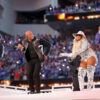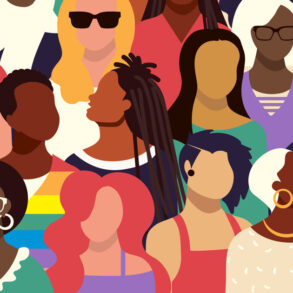What parts of contemporary culture have been most impacted by hip-hop, which this month celebrates its 50th anniversary and in 2017 surpassed rock as the most popular and widely consumed music in the United States?
Here’s a better question: What parts of contemporary culture haven’t been impacted by hip-hop? Its reach extends not just to music — from rap-metal and bro-country to the Broadway-and-beyond smash “Hamilton” — but also to visual art, dance, fashion, TV, movies, technology, literature, politics, education, Madison Avenue marketing campaigns and American and global culture at large.
“I’ve performed in 116 countries around the world since the 1980s — and it’s because hip-hop took me there,” said rapper and 2013 Rock & Roll Hall of Fame inductee Chuck D, the leader of the pioneering group Public Enemy.
“Hip-hop has become the most dominant form of Black music — and, pretty much, all music — in the world,” said Emmy, Grammy, Oscar and Tony Award-winning singer-songwriter John Legend, whose early collaborators included then-budding hip-hop phenoms Lauryn Hill and Kanye West.
Former Oingo Boingo rock singer Danny Elfman, whose film scores have earned him four Oscar nominations, offered a century-leaping analogy.
“The profound influence of hip-hop is equivalent to the profound influence that jazz had in the 1930s and ‘40s with people like Duke Ellington,” Elfman said. “Both are incredibly innovative art forms that have influenced many people and will continue to do so for many years to come.”

Tenants of 1520 Sedgwick Ave. walk through the lobby of their building in the Bronx section of New York, in this July 23, 2007, file photo. It is the same building where DJ Kool DJ helped pioneer hip-hop at a 1973 basement party.
(Seth Wenig / Associated Press)
Bronx basement to Harvard
That influence also stretches from elementary schools to the halls of education.
In 2012, the University of Arizona became the first four-year college to offer a minor in hip-hop. That was a decade after Harvard University opened its Hip-hop Archive & Research Institute. The number of annual symposiums focused on the music and its culture has grown exponentially in this century.
“If we want to look at American excellence, we have to look at hip-hop culture as part of the output of American excellence,” said award-winning spoken word artist Marc Bamuthi Joseph. The Kennedy Center’s artistic director of cultural strategy and vice president of social impact in Washington, D.C., Joseph was elected into the American Academy of Arts and Sciences last year.
“Hip-hop was born in August 1973 in New York, and I was born in November 1975 in New York, so I don’t know life without hip-hop,” Joseph continued. “Hip-hop was a lens for me on romance and love, and also on global political struggle and other difficult issues.
“Through the music and the propagators of the music, I learned about the apartheid struggles in South Africa and diasporic strategies. Hip-hop has been truly powerful for me and many others, not just culturally but academically.”
The Kennedy Center is just one of the nation’s cultural centers to embrace hip-hop in a big way. Like Harvard, the center seems a world apart from the music’s humble beginnings.
This month’s 50th anniversary of hip-hop is being pegged to a now-fabled party held in a Bronx basement rec room on Aug. 11, 1973. That was when Clive Campbell — a then-teenage Jamaican immigrant, soon to be known as DJ Kool Herc — played two copies of the same vinyl record.
He did so on side-by-side turntables, moving back and forth, from one record to the other. By mixing and fading between them, and focusing on snappy drum fills, he created the percussive, dance-friendly instrumental interludes — known as “breaks” — between the verses of the songs he was spinning.
Herc’s shouted words of encouragement to his dancing listeners, who he referred to as break-boys and break-girls (or b-boys and b-girls, for short) added to the excitement of the moment. It also helped lay the foundation for what soon became known as rap and hip-hop.
Breaking, which originated in New York in the 1970s, is the oldest style of hip-hop dancing. The term B-boy stems from the instrumental breaks on records, such as James Brown’s “Funky Drummer,” which hip-hop DJs would repeat to create dynamic tension on the dance floor.




The rhythmically propulsive music of James Brown has been foundational for many hip-hop artists since hip-hop’s inception 50 years ago.
(ASSOCIATED PRESS)
Jamaican roots
Herc’s Jamaican heritage played a key role in introducing the template for hip-hop in this country. Credit for this goes to such reggae-bred Jamaican-music traditions as mobile sound systems, microphone battles between DJs and speaking — known as “toasting” in Jamaica and emceeing in the U.S. — over the records being played.
Likewise, remixing — the art of sonically restructuring an existing recording of a song by modifying it subtly and overtly — dates to the mid-1970s in Jamaica. It was then that such Kingston-based music pioneers as King Tubby and Lee “Scratch” Perry created the bass-heavy dub reggae style by re-configuring recorded songs in the studio. They paved the way for such American mavericks as Steve “Silk” Hurley, Frankie “Knuckles” Taylor and Arthur Baker.
The absence of live instruments in the early days of hip-hop reflected a sobering socioeconomic reality. Budgets for arts programs — including music education — were largely eliminated at many public schools throughout New York City and in the early 1970s. Concurrently, the state of New York enacted some of the harshest mandatory sentences in the nation for first-time drug offenders.
That made turntables and microphones viable — and invaluable — alternatives for artistic expression, especially for young people in the inner-city with little or no access to guitars, keyboards, drums, horns and other instruments that had previously been available to them through school band programs.
Some have since sarcastically referred to former New York Governor Nelson Rockefeller as the “godfather of hip-hop” because of the draconian school budget cuts and drug laws he helped engineer.
Hip-hop, in many ways, was a reaction to those grim social and political realities. It provided a much-needed means of expression for disenfranchised youth who seized the opportunity to articulate their lives through music.
The records first played by Herc at that 1973 basement party — initially classics by James Brown, The Incredible Bongo Band and the Canadian rock group Babe Ruth — served as another template for hip-hop, which salutes a dizzying array of genres by sampling and recombining them in new ways.
Herc will perform Friday at New York’s Yankee Stadium as part of a massive Hip-Hop 50 Live concert. The 32-act bill mixes such old-school favorites as Run DMC, Kurtis Blow, Roxanne Shante and The Sugarhill Gang with Snoop Dogg, Common, Wiz Khalifa and A Boogie Wit Da Hoodie.
No major 50th anniversary of hip-hop concerts are scheduled in San Diego, although rappers 50 Cent and Busta Rhymes will perform Aug. 31 at North Island Credit Union Amphitheatre in Chula Vista. On Sept. 30, the Kroc Center in Rolando will host “We Are Hip-Hop — 1973-Forever,” which features students and staff members from The Origin Hip-Hop Academy and Hip-Hop Dreamz Performing Arts.
Rapping itself originated hundreds of years ago with the West African tradition of the griot, the oral historians who wrote and performed songs to document in music the past and present of their people. That tradition, which continues to this day, was extended in the late 1960s and early 1970s by such pioneering rap artists as The Last Poets in New York and The Watts Prophets in Los Angeles.
“We’re all products of that continuum, whether we recognize it or not,” acclaimed rapper and actor Mos Def told The San Diego Union-Tribune in 2002. (Unless otherwise specified, all the other quotes in this article are from Union-Tribune interviews conducted over the past few months.)
“Do I want to use that tradition as a guide, and to improve on it in a useful way that doesn’t molest the tradition?” Def asked. “Sure … Scholars, critics and academics understand the connection between (griots), the blues and jazz and hip-hop; young people — ghetto people, poor people — should know it, too. It shouldn’t be information that’s classified for the high academic or cultural strata. If something’s good, why keep it a secret?”




Eminem, Kendrick Lamar, Dr. Dre, Mary J. Blige, 50 Cent and Snoop Dogg and Kendrick Lamar perform during the halftime show at Super Bowl LVI at SoFi Stadium on Sunday, Feb. 13, 2022 in in Inglewood, CA.
(K.C. Alfred/The San Diego Union-Tribune)
Silver anniversary
The celebration of the 50th anniversary of hip-hop got off to an early start at last year’s Super Bowl halftime show. The lineup included Dr. Dre, Snoop Dogg, Mary J. Blige, 50 Cent, Eminem and Compton native Kendrick Lamar, who in 2018 became the first hip-hop artist to win a Pulitzer Prize for music.
Lamar’s 2017 album — the all-uppercase “DAMN.” — earned a Pulitzer Prize, the first hip-hop album win the prestigious honor.
The Pulitzer voting committee hailed “DAMN.” as “a virtuosic song collection unified by its vernacular authenticity and rhythmic dynamism that offers affecting vignettes capturing the complexity of modern African-American life.”
Lamar’s victory came on the heels of playwright and actor Lin Manuel-Miranda’s 2015 hip-hop musical “Hamilton.” The Pulitzer judges hailed it as “a landmark American musical about the gifted and self-destructive founding father whose story becomes both contemporary and irresistible.”
The silver anniversary of hip-hop officially got under way this February at the Grammy Awards. There, drummer and Oscar-winning documentary filmmaker Ahmir “Questlove” Thompson — the leader of The Roots, the house band on TV’s “The Tonight Show Starring Jimmy Fallon” — curated a 50th anniversary hip-hop tribute.
Clocking in at 14 minutes, it featured nearly three-dozen performers, including Grandmaster Flash, Salt-N-Pepa, LL Cool J, Queen Latifah, Lil Baby and La Jolla resident Swizz Beatz, who is the husband of singer Alicia Keys.
The Grammy salute was a prelude to many other anniversary events across the country and around the world. These range from the Brooklyn Library’s current Jay-Z exhibit to The Smithsonian’s National Museum of African American History and Culture’s second annual Hip-Hop Block Party, which takes place Friday in Washington, D.C.
“Hip-hop is a culture and a lifestyle, and it is always timely,” said Public Enemy’s Chuck D, whose real name is Carlton Douglas Ridenhour.
Now 63, Chuck D this year launched a “culture app” for people 35 and older called Bring the Noise. It is named after the galvanizing opening song on Public Enemy’s second album, 1988’s “It Takes a Nation of Millions to Hold Us Back.”
The group’s next album, “Fear of a Black Planet,” concluded with the even more galvanizing “Fight the Power,” which served as the opening song for the Spike Lee’s Oscar-nominated 1989 film “Do the Right Thing.”
“Hip-hop was a revolutionary music when it first came out, which is something it has in common with reggae,” said singer-songwriter Ziggy Marley, the oldest son of the late Bob Marley. “Artists like Public Enemy, KRS-One and Kendrick Lamar have powerful messages.”
Indeed, Lamar’s 2015 song “Alright” served as a pivotal social protest anthem at numerous Black Lives Matter marches. “Alright” was denounced, on the air, by Fox TV’s Geraldo Rivera, who slammed the song’s revolutionary zeal and sometimes grim lyrics but completely overlooked its ultimately uplifting message of hope.
Lin-Manuel Miranda and the cast of “Hamilton” perform at the Tony Awards in New York on June 12, 2016. In addition to its multiple Tony wins, the hip-hop fueled “Hamilton” went on to win a Pulitzer Prize.
(Evan Agostini/Invision/AP)
Global impact
Speaking of television, Public Enemy’s Chuck D did not describe rapping and hip-hop in 1989 as “CNN for Black people,” although he is often credited for doing so. What he did say is: “Rap is Black America’s TV station. It gives a whole perspective of what exists and what Black life is all about.”
His observation came one year after the the debut of “Yo! MTV Raps.” The show, which aired for two hours each weekday from 1988 to 1993, quickly became the most-watched program on MTV.
It introduced hip-hop to millions of White male suburban American teenagers, who soon constituted the largest segment of the hip-hop-buying public for records, clothing, posters and more.
The success of “Yo! MTV Raps” prompted MTV to air the shows in dozens of countries around the world. This in turn enabled hip-hop and contemporary Black American culture to make an indelible impact.
“When you go to other countries, they pay more attention to the roots and history of hip-hop than they do in the U.S. Kids in Europe know things about hip-hop in the 1980s that I had forgotten about,” said Cypress Hill rapper and Cuban native Sen Dog. His group celebrated its 30 anniversary with a July 25 concert with the San Diego Symphony, which last year shared the stage here at concerts with hip-hop stars Common and Nas.
That impact crosses borders and genres.
“My vocal style is very much influenced by hip-hop, Alex Turner, the lead singer of the English rock band Arctic Monkeys, told the Union-Tribune in 2006. “When I was at school, I liked Cypress Hill, Roots Manuva and stuff like that.”
Then there’s fellow Brit Jamie Cullum, who became a star performing jazz-informed pop.
“I got into jazz by listening to (hip-hop group) A Tribe Called Quest,” Cullum told the Union-Tribune in 2006. “I heard a Miles (Davis) sample on a Tribe song and sought out the original record by Miles. Then, I got his ‘In a Silent Way’ album and Herbie Hancock’s ‘Headhunters,’ and heard how similar they were to Massive Attack, Roni Size and other (electronica) music I was listening to.”
Like rock music before it, hip-hop was largely created by Black American artists as a vital means of expression that can reflect — and transcend — its time and place.
Like rock, hip-hop celebrates excess and larger-than-life imagery, the larger the better, as well as more intimate and personal aspects of everyday life. It can be inspirational and aspirational, serious and lighthearted, revolutionary or reductive.
“Growing up in the hip-hop generation, I was always influenced by hip-hop as a powerful tool, because it influences a lot of young people,” said Nigerian-born musician Seun Kuti, the son of Afro-pop legend Fela Kuti.
“But then it became a multinational corporate brand, and hip-hop became a corporate vending machine and lost the ideals of preaching black empowerment. I used to love Public Enemy and their song, ‘Fight the Power.’ I don’t see them fighting the power now.”
Indeed, hip-hop can also be banal and trite, much like rock music. But like rock, hip-hop has provided a key platform for disenfranchised young people who otherwise had little or no voice — and little or no options to be seen and heard.
Like rock, hip-hop has fueled considerable controversy for being profane and sexist, dangerous and threatening, and for inciting rebellious and sometimes even violent behavior. Like rock, what resulted offended or outraged many parents and authority figures, which — as with other music styles before it — accounted for part of hip-hop’s allure to young listeners.
“Of course, hip-hop is a bigger microscope than other musical styles because, I believe, the Black male lifestyle is under a bigger microscope.” Ahmir “Questlove” Thompson, the leader of the band The Roots, told the Union-Tribune in 2002.
“So the more negative aspects of it will get focused on more often than not. But I’m a person who investigates the whole terrain of a culture, be it Johnny Cash and Waylon Jennings, or rock, where you have cool stuff and politically incorrect stuff.”
Like rock, hip-hop was created by young Black musicians and then embraced and appropriated by young White performers, most notably the Beastie Boys and Eminem, who enjoyed greater commercial success than many of the Black artists who inspired them.
In 1981, the Debbie Harry-fronted rock band Blondie’s “Rapture” became the first hip-hop-oriented song to top the U.S. pop singles charts.
“We were really pleased,” Blondie guitarist Chris Stein told the Union-Tribune in 2006. “but ‘Rapture’ was sort of an homage (to hip-hop), more than an attempt to do it.”
The commercial success of “Rapture” came 42 years ago. That was eight years after DJ Kool Herc first demonstrated that two turntables and a microphone were all that was needed to start, and sustain, a party that birthed a transformational movement.
Ultimately, like rock — which marked its own 50th anniversary in 2004 — hip-hop has endured and been so embraced by the mainstream that it has become part of the very establishment it once threatened.
“Hip-hop has become foundational,” said John Legend. “That’s something to really celebrate.”







